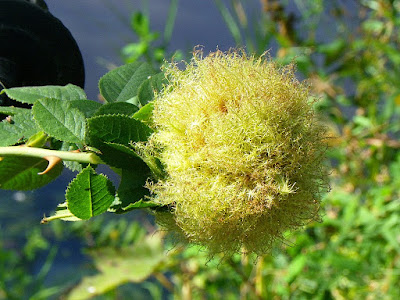Now we've found them in Cougar Creek park, and well within reach.
A different kind of rose.
I had found references to them on the web; Wikipedia has an article about them. They're Bedegaurs, or Robin's pincushions; galls produced by a small wasp, Diplolepsis rosae, probably. Although there are other wasps that cause the rose to wall them off in galls, those are "normal" galls, smooth-skinned. Good to know, but I had to see for myself.
I broke off the largest ball, getting well scratched in the process. The gall was cool and dry to the touch, and quite firm under the fiber coating. (Wikipedia says the filaments are sticky; I didn't notice this. It felt more like a dry moss.) It had a mild apple (or better, apple shampoo) scent, quite pleasant. I stuck it in my pocket and brought it home.
Rose gall "moss". Just beginning to turn pink.
I laid it on my kitchen counter, and aphids spread out around it. I probably had aphids in my pocket, too. It wouldn't be the first time.
With a sharp knife, I sliced the gall down the centre. It was surprisingly easy; I've cut other galls and found them woody. This was like slicing a carrot. In the white centre were a number of smooth, round holes, each with a white larva coiled inside.
Amazingly, only one half-larva.
The wasp that laid the eggs in the rosebud was a tiny, black, parthenogenic female. The larvae hatched a week later, and began to feed. The rose responded by surrounding each larva with large food cells, replacing them as needed to feed the growing invaders. In turn, these were walled off by smaller cells (the green layer in the photo), and then by a thick growth of branched fibers.
The ones we found at Crescent Beach were a deep pink; they were ripe, then. They start off green, turn pink, dry up and turn brown. They stay on the rose until spring, when the adult wasp burrows its way out.
One of the larvae.
I found only one species of larva in this gall. But there could be others:
A gall provides the developing gall wasp with a safe refuge for the most vulnerable stage of its life-cycle, however, many other wasps have found a way penetrate this defence and parasitise the larva(e) within. Some of these parasitoids use their long, hardened egg laying tube (ovipositor) to bore into the gall and lay an egg on the helpless gall maker. Collect a Bedeguar or robin's pincushion gall before the autumn and keep it somewhere cool. In the spring, you will see at least one species of parasitoid emerge instead of the gall maker. These wasps, such as Eurytoma rosae are beautiful, metallic insects with long ovipositors. (Wikipedia)
This I must do. Next time I see one, it's coming home with me. Not in my pocket, though.





Wow!! How amazing! We (my children and I) have been interested in galls and learning more about them since we have them on the Garry Oak trees around here, but those are all smooth galls. What an informative post!
ReplyDeleteI used your gall photo on my blog. We found some of these galls last summer and put them in a jar, which we forgot about until today. We found no gall wasps, but a number of amazingly beautiful Jewel Wasps, a parasitoid of the gall wasps. Nature is always full of surprises!
ReplyDeletehttp://www.luterra.com/blog/?p=235
Mark Luterra
Corvallis, OR